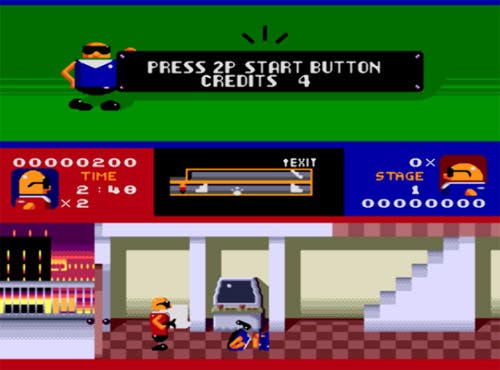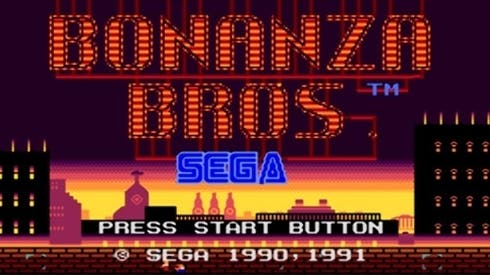Bonanza Bros and the 16-bit difference
Crims and whims.
Bonanza Bros was the first Mega Drive game I ever played. It was the reason I was interested in the machine in the first place. Today I would put it up there with Quackshot and ToeJam & Earl as one of the handful of games that for me makes that machine so exciting. (I appreciate Gunstar Heroes belongs on this list too, but I had temporarily moved on from video games by the time that came out and I had to discover it much later.)
Even now, Bonanza Bros sums up what made 16-bit gaming so astonishing. On the surface, this is pretty simple stuff. You play as a robber - or two robbers in co-op - who break into various types of buildings, race around nabbing the stuff you're after, fighting off guards and then making it to the roof where a sort of airship allows you to escape. It's a pretty basic thing to play - I think the first time my friend plugged it into his Mega Drive he completed it in one sitting.
But that wasn't the full story - and the game mechanics not being the full story was what 16-bit gaming was all about. Games suddenly had time for incidental details. Sonic tapped his foot if you left him long enough, the kids in Mystical Ninja put their heads through funny hole-riddled statues for no reason. And in Bonanza Bros? Bonanza Bros was filled with incidental detailing.

These are the things I remember the most. I remember you could trip on a coke can in one level and fall over. I remember if you leaned against a door for too long a fly would come and land on your head. I remember that if you missed a bounce pad you might crash into the floor and be buried, head-first, legs sticking out for a few seconds. You might surprise a housekeeper who would drop their plates. All of this stuff was by the bye as much as the central point of the game was concerned, but it spoke to a degree of freedom and imagination and whimsy that these new 16-bit machines allowed. Mode 7 on the SNES was great, sure, but 16-bit will forever be the whimsy era for me, the point at which even the most straightforward of games suddenly had the bandwidth for a bit of extraneous quirk.
Looking back now, there's more too. Bonanza Bros' graphical style is so interesting, I think, because it was a glimpse of the future - a very strange glimpse. The Bonanza Bros themselves and their rounded, shiny world, was created to look like it was made with the early 3D graphics of the time. But it's really just 2D spritework. How brilliant and weird: 2D games trying to ape the aesthetics - and graphical shortcomings - of the 3D tech of the moment. Arms aren't joined to bodies, textures are uniformly glossy, and yet it's all fake. It aspires to something which is itself a work in progress.

Oh yes, and there's one more thing. Bonanza Bros was not a tricky game as I have mentioned. It did not take us long back in the day to assume that we had seen everything in it. And yet there was one little detail that always confused me. In the option menu, you get the chance to do a sound test, to prod your way through every individual sound effect in the game. (I still don't understand why games today have ditched this sort of thing.) I spent hours back then listening to each hiccup, yelp, and splat. The buzz of that fly, the snap of the Bonanza Bros gun. But Sound Test 11? Sound Test 11 is a sprightly little jingle that I have never been able to find in the game itself. What is it? Where is it from? Is there some layer of mystery that escapes me even now?









